You are viewing 1 of your 1 free articles
Creating and finishing centrally
| Area | Up to full pitch |
| Equipment | Balls, bibs, cones, 3 small target goals, 2 full size goals |
| No. of Players | Up to 14 players + 2 goalkeepers |
| Session Time | Attacking through the middle: 30mins Finishing practice: 15mins Combining to attack: 15mins Small-sided game: 15mins |
This session is focused on creating opportunities to score and finishing under pressure centrally in and around the penalty area. It helps players to improve their ability to shoot through a crowded box and works on their one-touch finishes and reactions. It also rehearses players to create chances for their team-mates.
Players enjoy this session because it creates plenty of high intensity moments in and around the penalty area, making it a highly realistic practice for those players who find themselves in similar scenarios or positions during a game.
As the session develops with additional targets for the defensive players, it increases in intensity to ensure that it is competitive for both sets of players, as well as being relevant to the types of situations they will face in their positions.
I would tend to use this session on a Tuesday during a clear week, on a day when physically I want to work on short, sharp explosive movements and reactions, often with split groups and specific players. I would use it when I felt that we were due to face opponents that defend deep.
“Players enjoy this session because it creates plenty of high intensity moments in and around the penalty area, making it a highly realistic practice”
ATTACKING THROUGH THE MIDDLE
We set up on the final third of the pitch with a goal and a goalkeeper positioned as normal. Three small target goals are positioned outside the penalty area, as shown. We mark out two zones in front of the goal. Both zones are the same width as the six-yard box but the inner zone is 14 yards deep from the goal line and the outer zone is 12 yards deep starting from just inside the penalty area. The two zones are separated by a dead zone of two yards.
We’re using 12 outfield players split into a red attacking team of six and a blue defending team of four, plus two yellow target players. The reds and the blues go up against each other in a 3v2 in each zone and the yellow target players are positioned either side of the small target goal. Each round consists of three separate attacks.
Attack 1 is started by the coach outside the penalty area who serves a ball into one of the three red attackers in the outer zone (the zone furthest from the goal). The aim for the reds is to utilise the 3v2 overload situation to create an opportunity to strike at goal from the outer zone, meaning that the shot will have to be taken from the edge of the penalty area or beyond, as shown [1a].
Attack 2 is started by the same coach who again passes to a red attacker in the outer zone. The aim this time is for the three red attackers is to find a way to play the ball forward to one of their team mates in the inner zone (the zone nearest the goal). The three red attackers in the inner zone then combine under pressure from the two blues to create a goal-scoring opportunity, as shown [1b].
Attack 3 is started by the coach to the side of the goal, who plays a ball into the inner zone for one of the three red attackers to produce a quick one-touch finish, as shown [1c].
[1a]
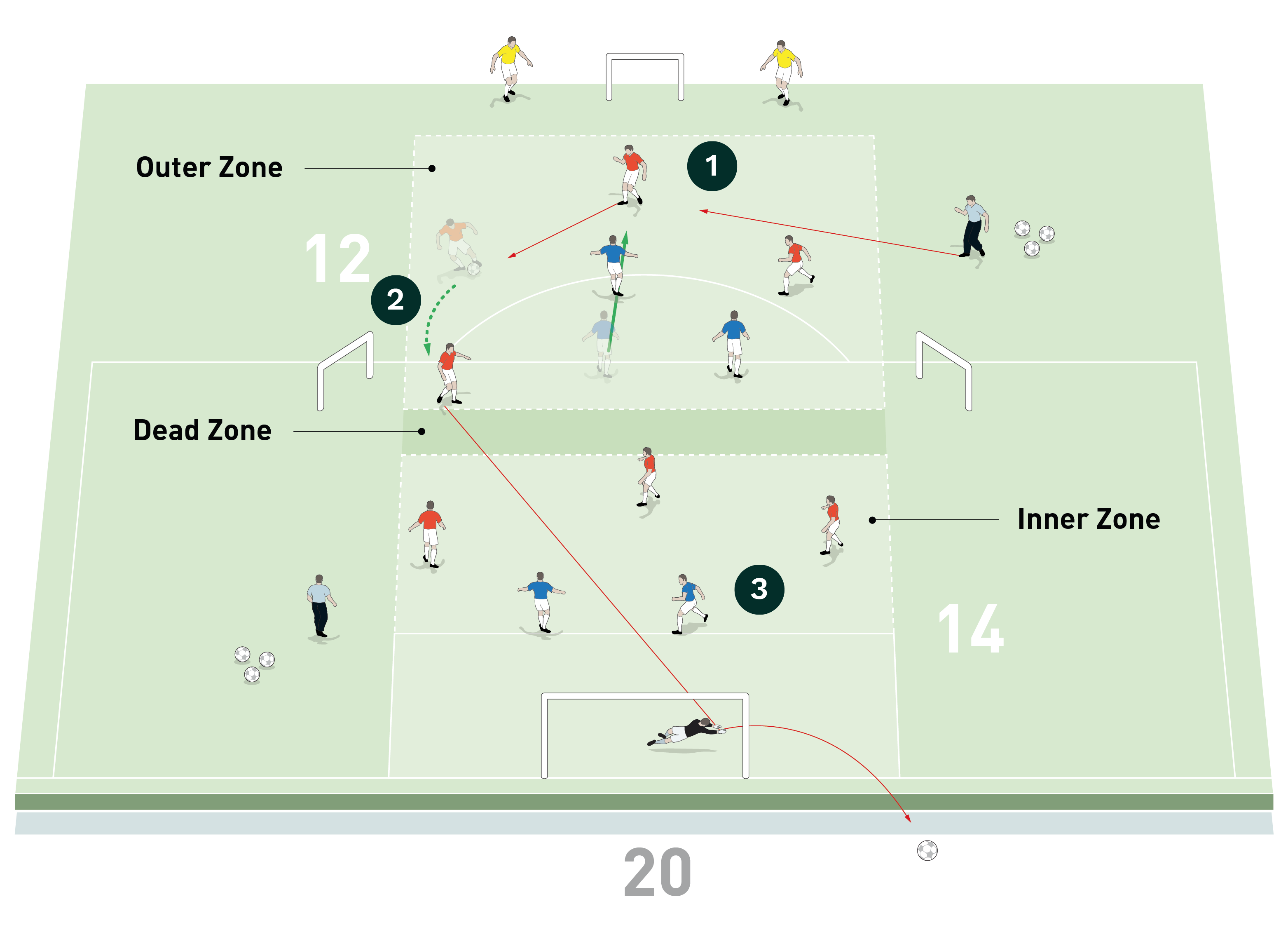
2. The aim for the reds is to use their 3v2 overload to create an opportunity to take a shot at goal from the outer zone
3. The blue defenders should try to defend centrally and block any goal attempts
[1b]
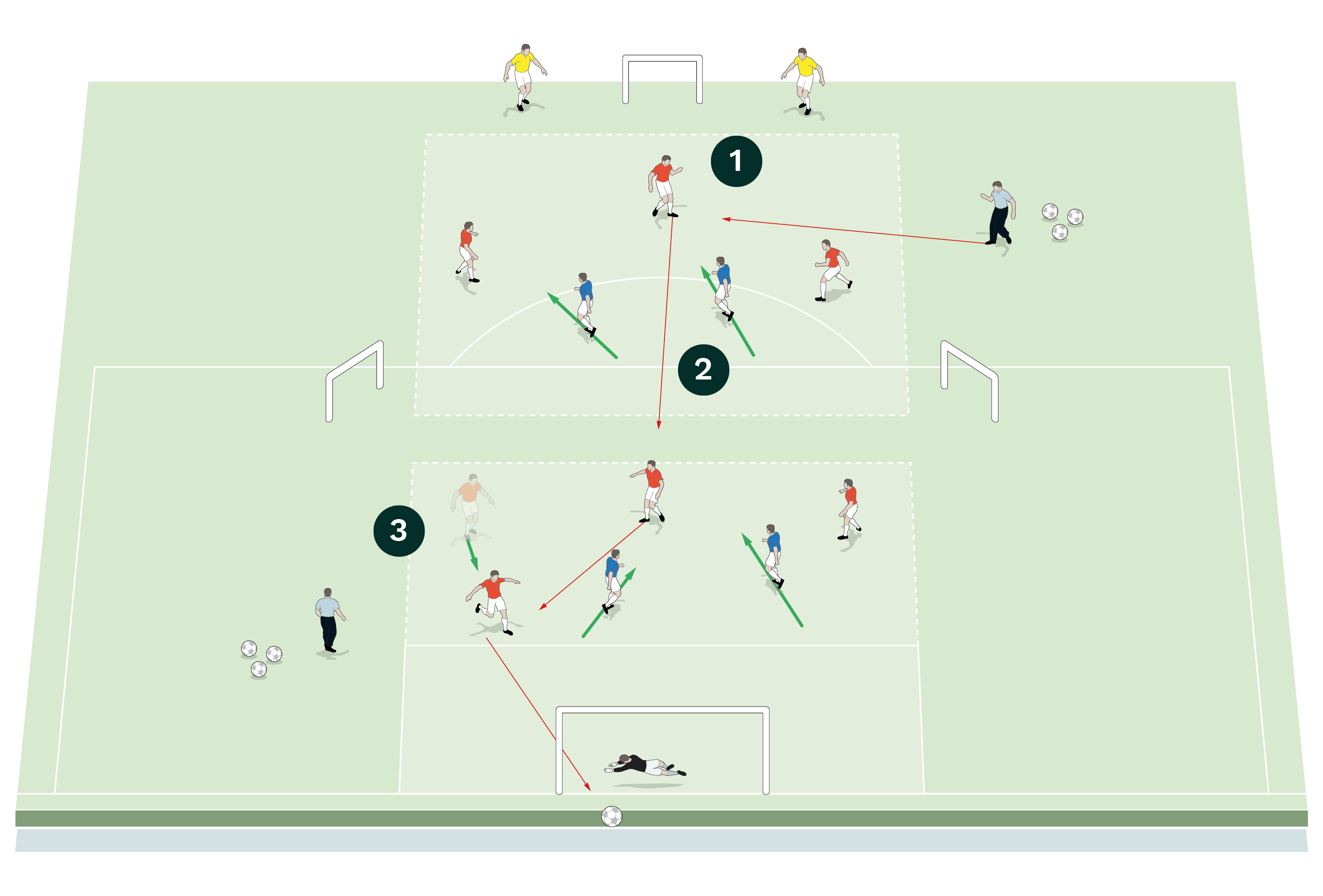
2. The aim is for the red attackers in the outer zone to combine to create a chance to pass forward into the red attackers in the inner zone
3. The three red attackers in the inner zone must then combine to create a goal scoring opportunity
[1c]
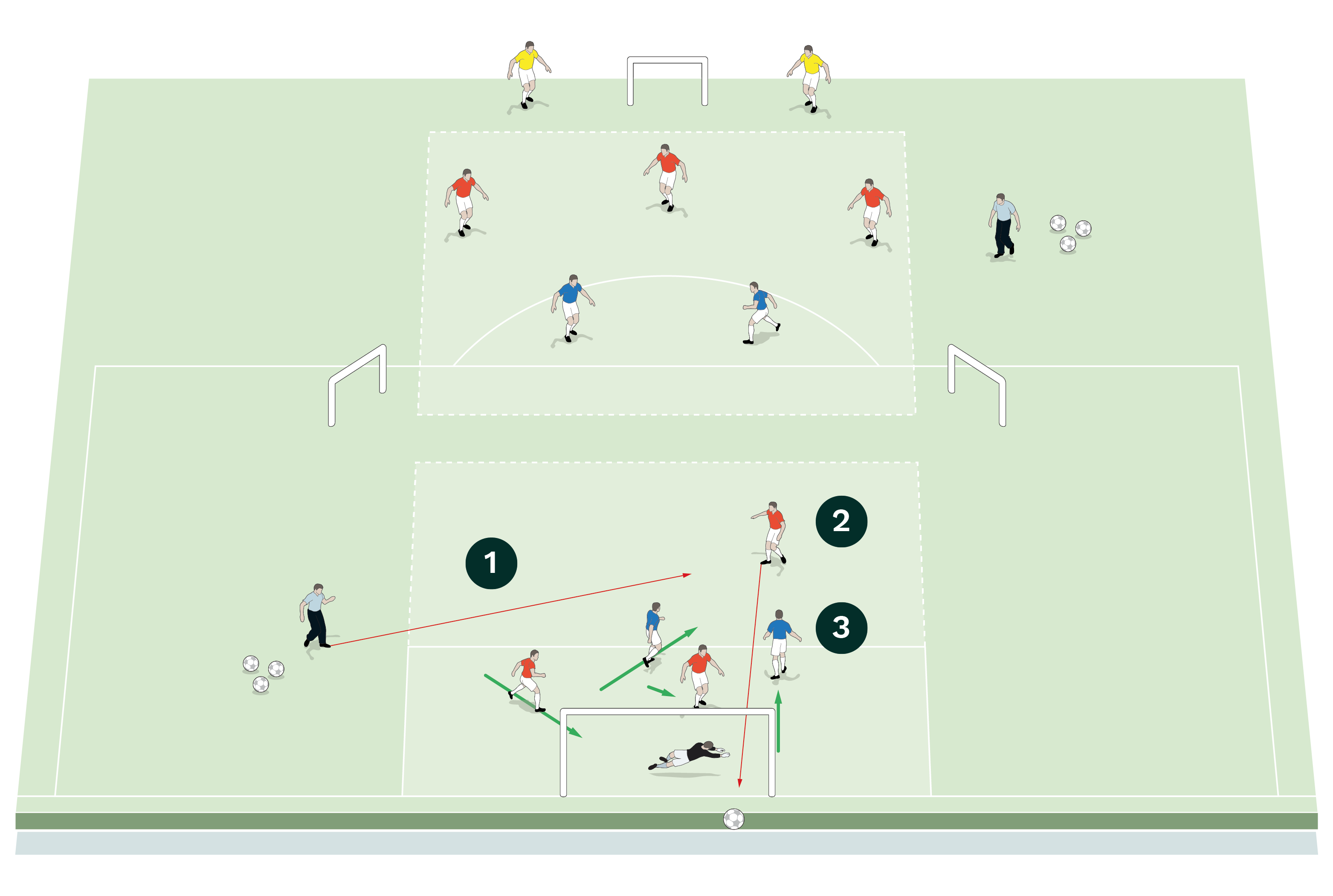
2. One of the three red attackers should try to take a quick first-touch shot on goal
3. The blue defenders aim to block any goal attempts
[1d]
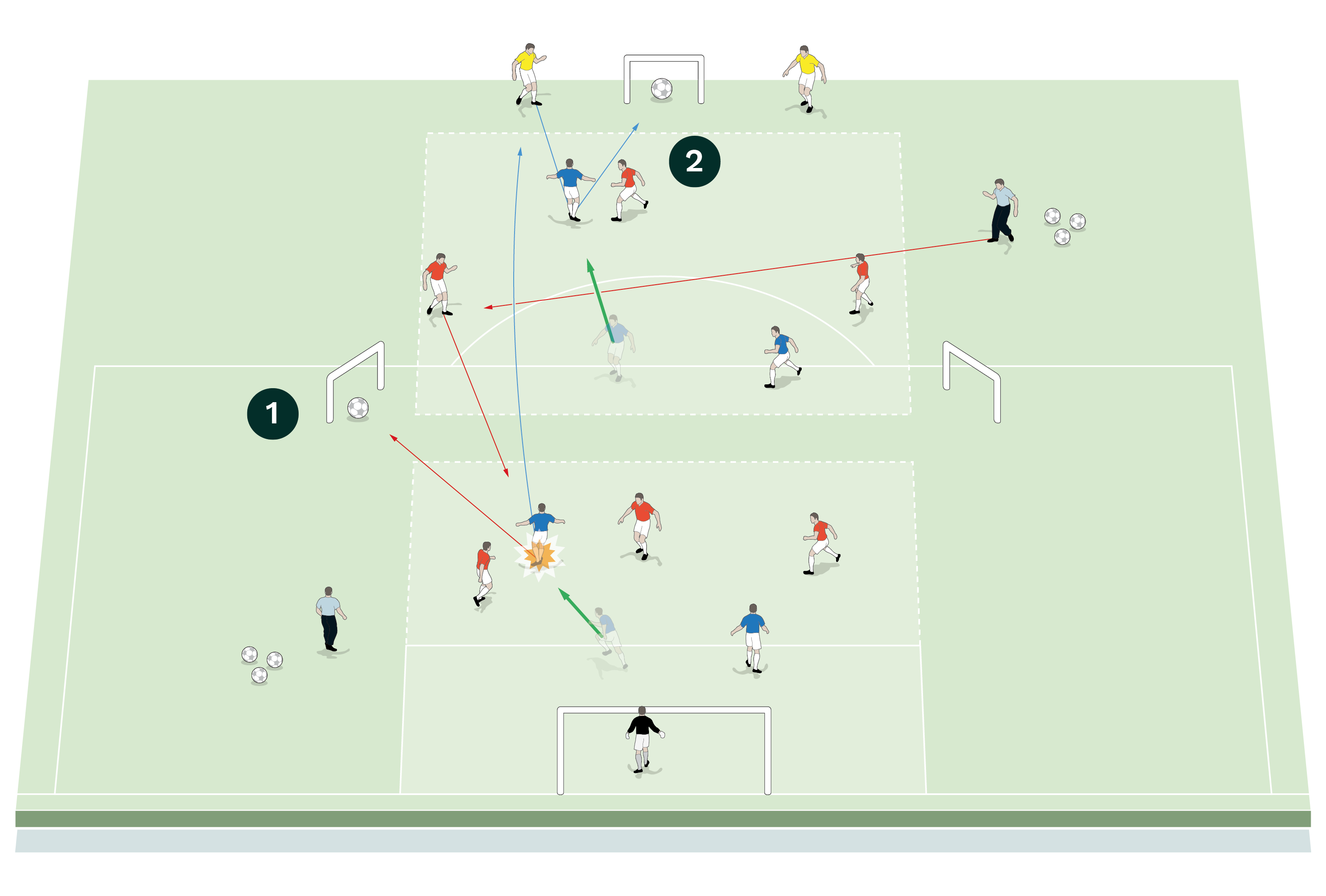
2. Another option for the blues if they win possession is to bounce the ball off a yellow target player before attempting to finish in a mini goal
FINISHING PRACTICE
We set up in the penalty area of the pitch with a goal and a goalkeeper positioned as normal and with the inner zone from the previous activity still marked out with cones. We’re using five outfield players split into a team of three red attackers and a team of two blue defenders. Each round consists of four separate attacks and the aim for the reds is to rehearse shooting at goal from central positions. It also gets players to think about angled passes and straight runs, and about straight passes and angled runs.
Attack 1 sees a red forward play the first ball into the red striker, who turns and strikes at goal. The red striker can be pressed by the blue defender but only after the striker has taken a first touch, as shown [2a].
Attack 2 begins immediately the first ball is dead, with another red forward playing a second ball into the striker. The striker has dropped to receive and turns before shooting at goal, as shown [2b].
[2a]
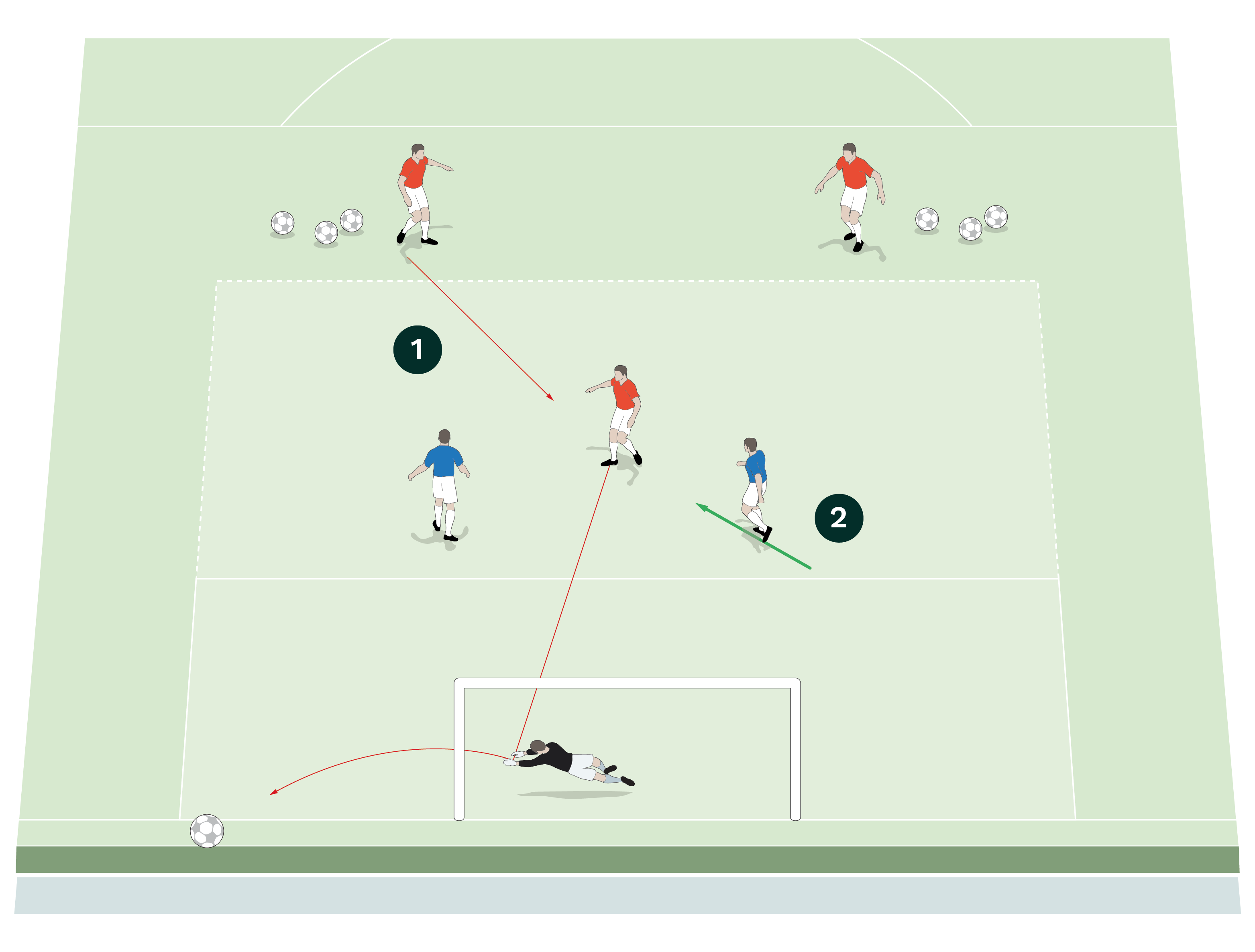
2. The red striker can only be pressed by the blue defender after he has first touched the ball
[2b]
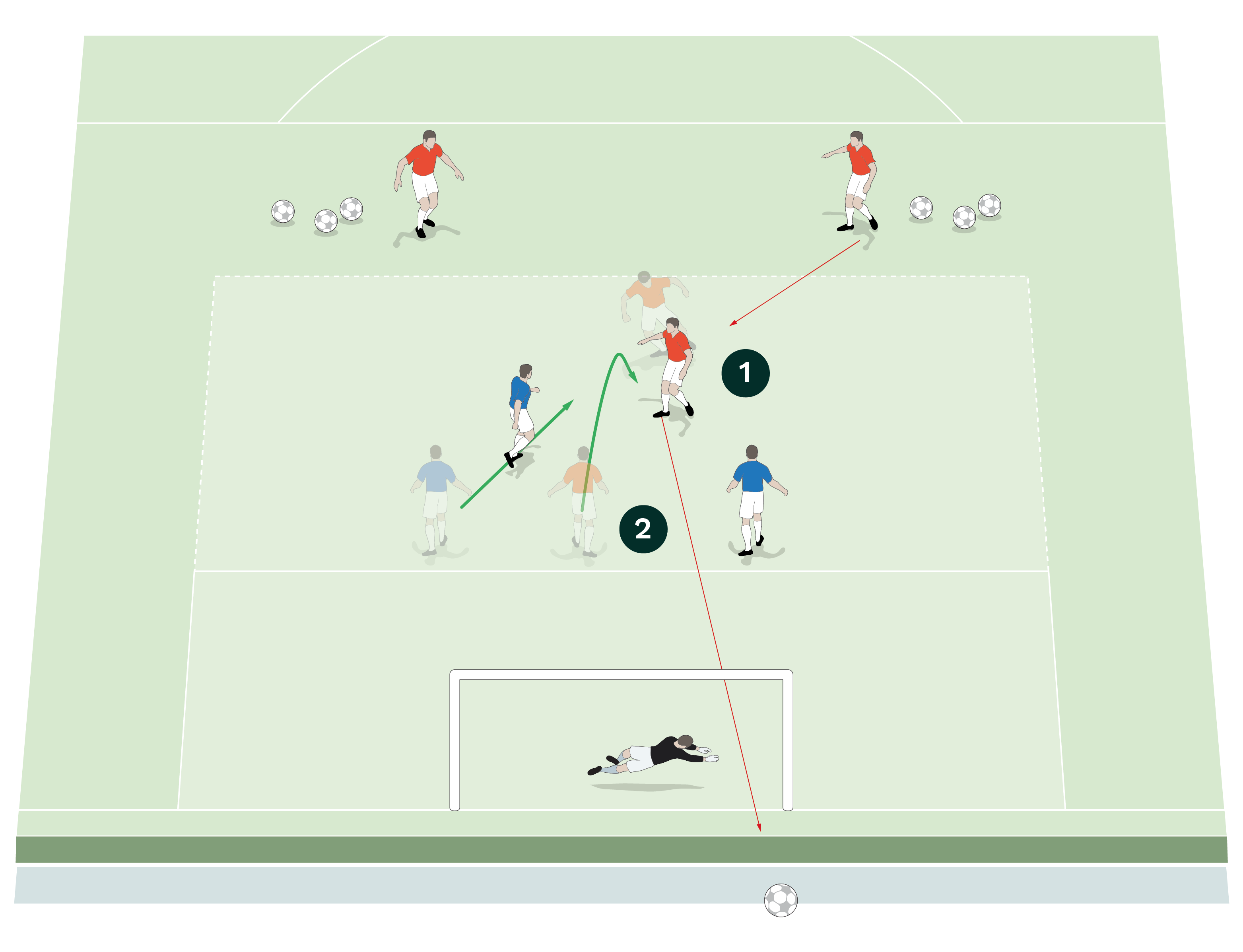
2. The red striker has dropped to receive and turns before striking at goal
[2c]
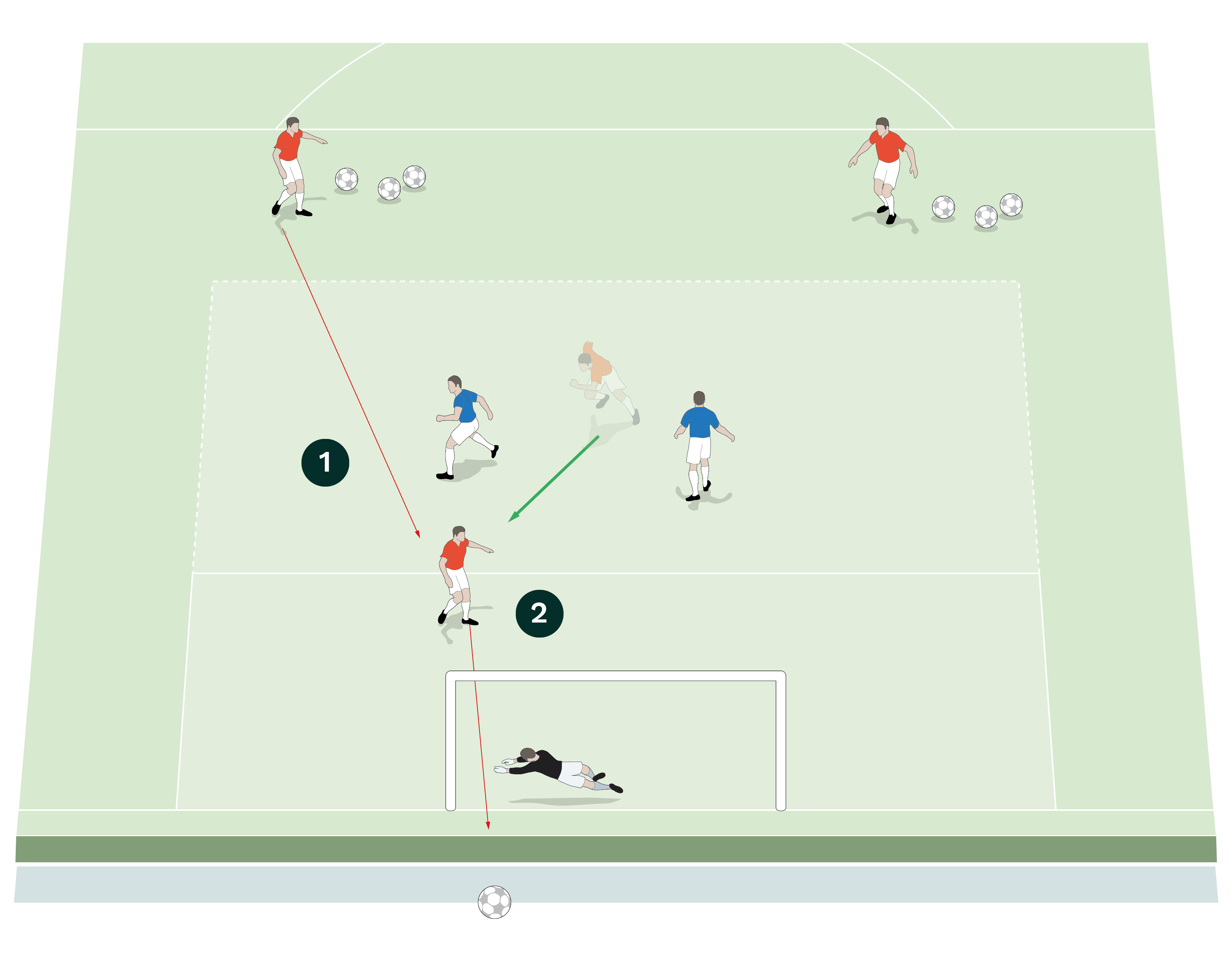
2. The red striker has made a darting diagonal run in behind to receive and lets the ball run before finishing first-time
[2d]
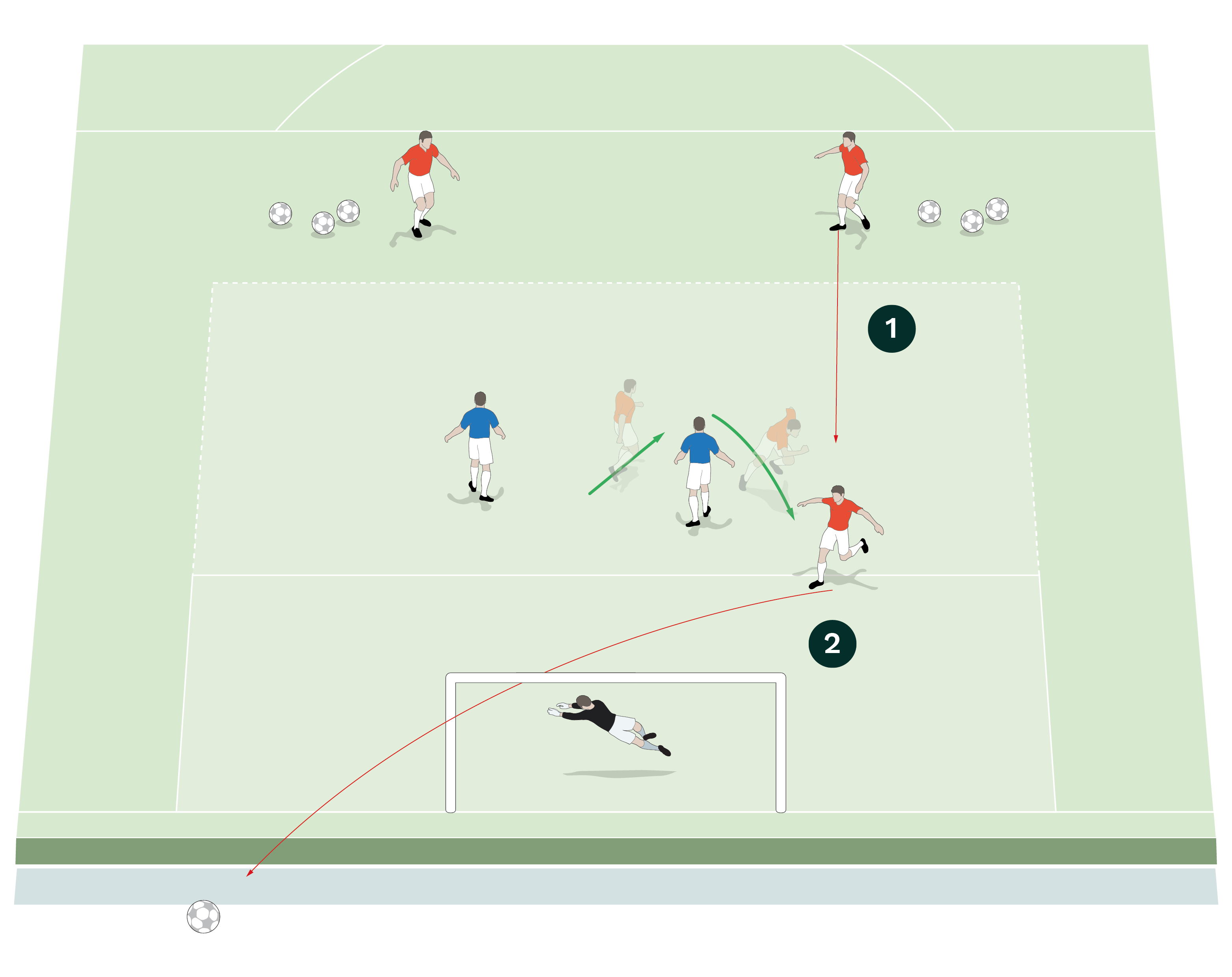
2. The striker has made a run across the face of the blue defender to finish with a first-time strike at goal
“Key aspects that we want to see from the strikers include good 1v1 play and quick combination play around the box”
Attack 3 begins as soon as the second ball is dead, with a third ball being played down the outside shoulder of the blue defender and into the path of the red striker, who has made a darting diagonal run in behind. The red striker should let the ball run across him before finishing first-time, as shown [2c].
Attack 4 begins when the fourth and final ball is played into the red striker, who has made a run across the face of the blue defender with the aim of again finishing with a first-time strike at the goal, as shown in this example [2d].
We would run this activity for 15 minutes.
COMBINING TO ATTACK
[3a]
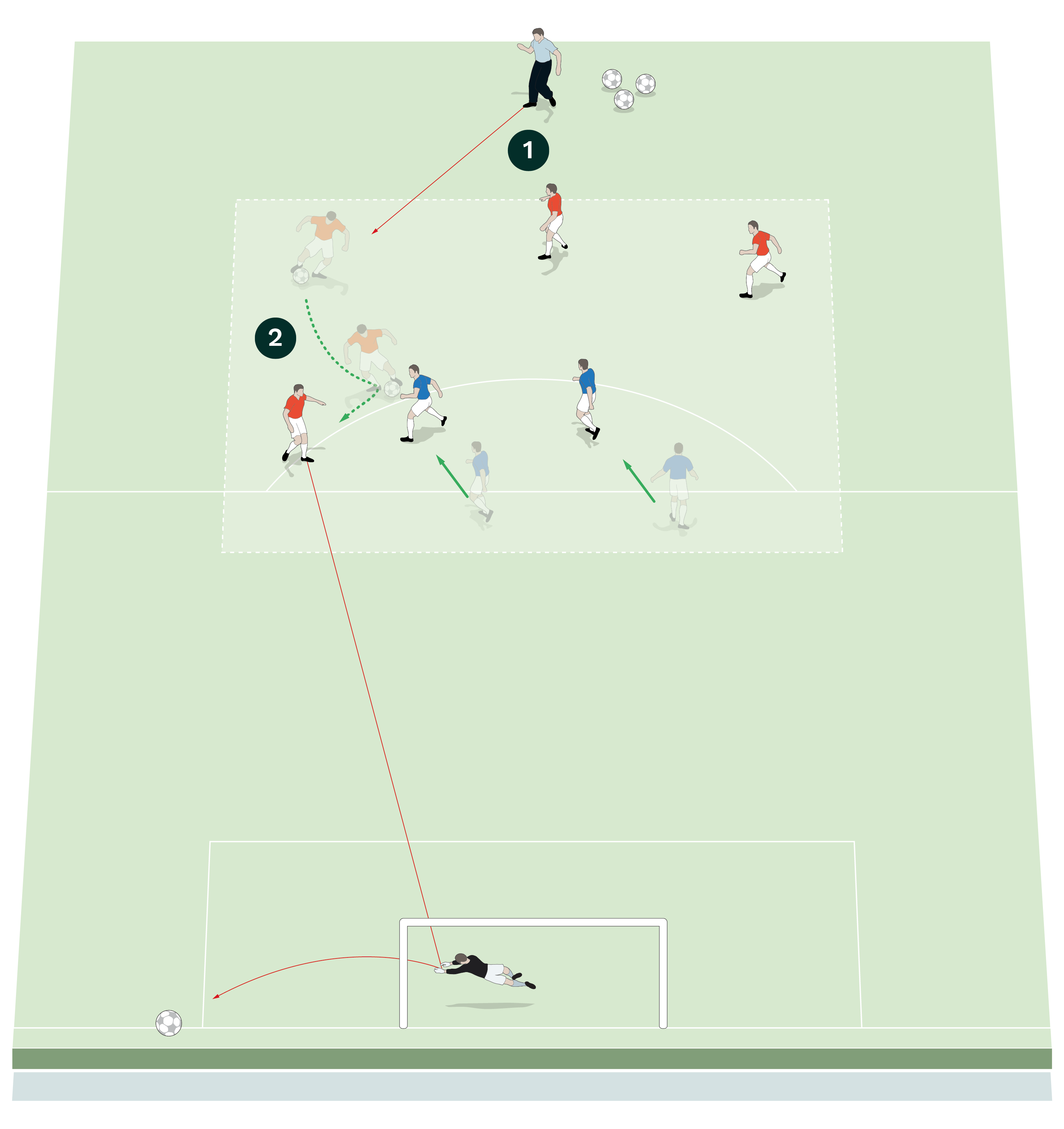
2. In this example the red attacker beats the blue defender in a 1v1 and gets a shot off at goal
[3b]
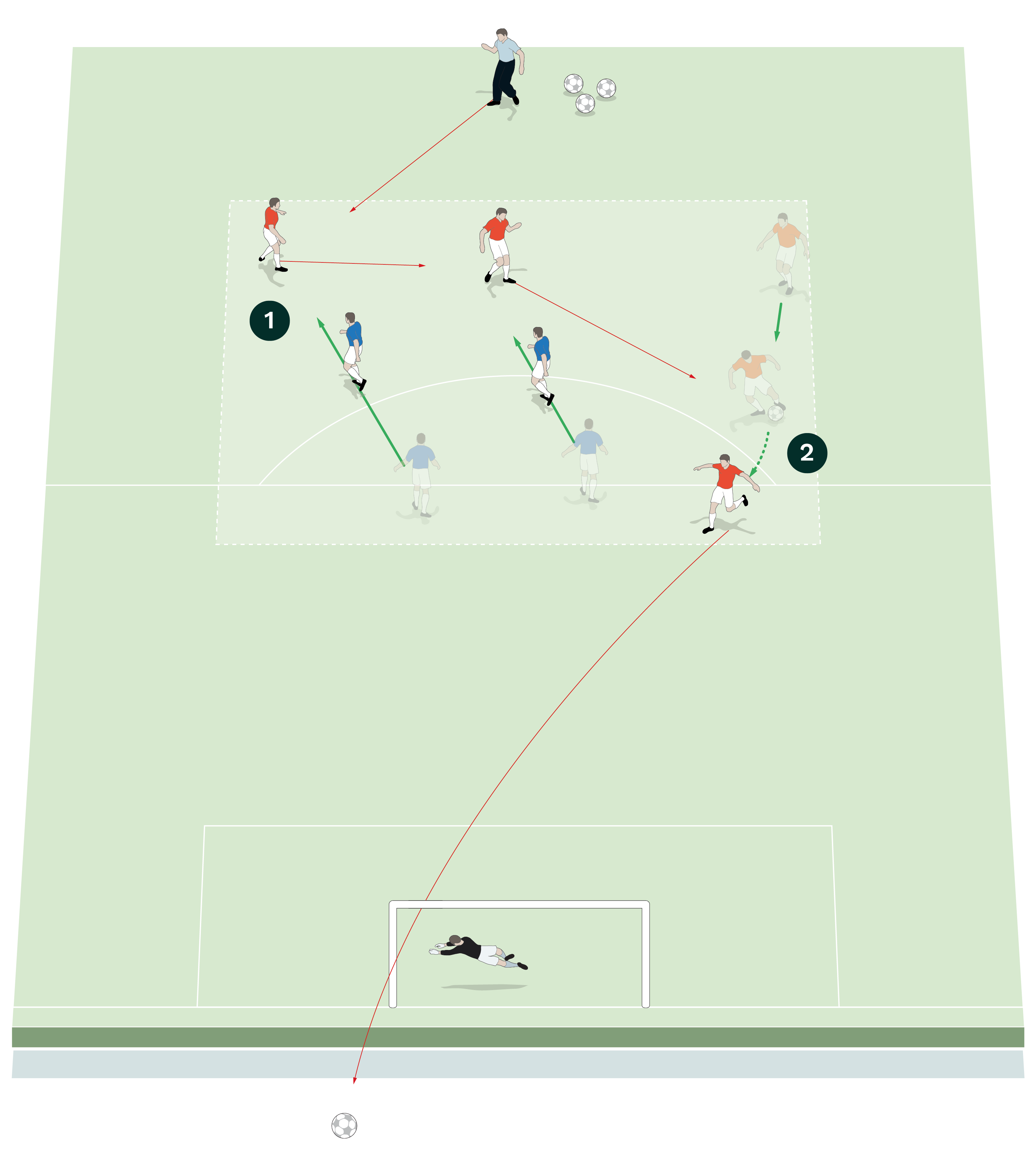
2. Here the reds use their 3v2 overload in the outer zone to find the free player who can then strike at goal
We set up in the final third of the pitch with a goal and a goalkeeper positioned as normal and with the outer zone from the first activity marked with cones. We’re using three red attackers and two blue defenders.
Each round consists of three separate attacks and the aim for the reds is to rehearse attacking in 1v1s, 2v1s and 3v2s. If shooting from the outer zone, they have unlimited touches but any shot taken closer to the goal must be made first-time.
Attack 1 begins when the coach plays the first ball into one of the three red attackers, who are up against the two blue defenders in the outer zone. In this example the red attacker tries to beat the blue defender in a 1v1 with the aim of getting a shot off at goal, as shown [3a].
[3c]
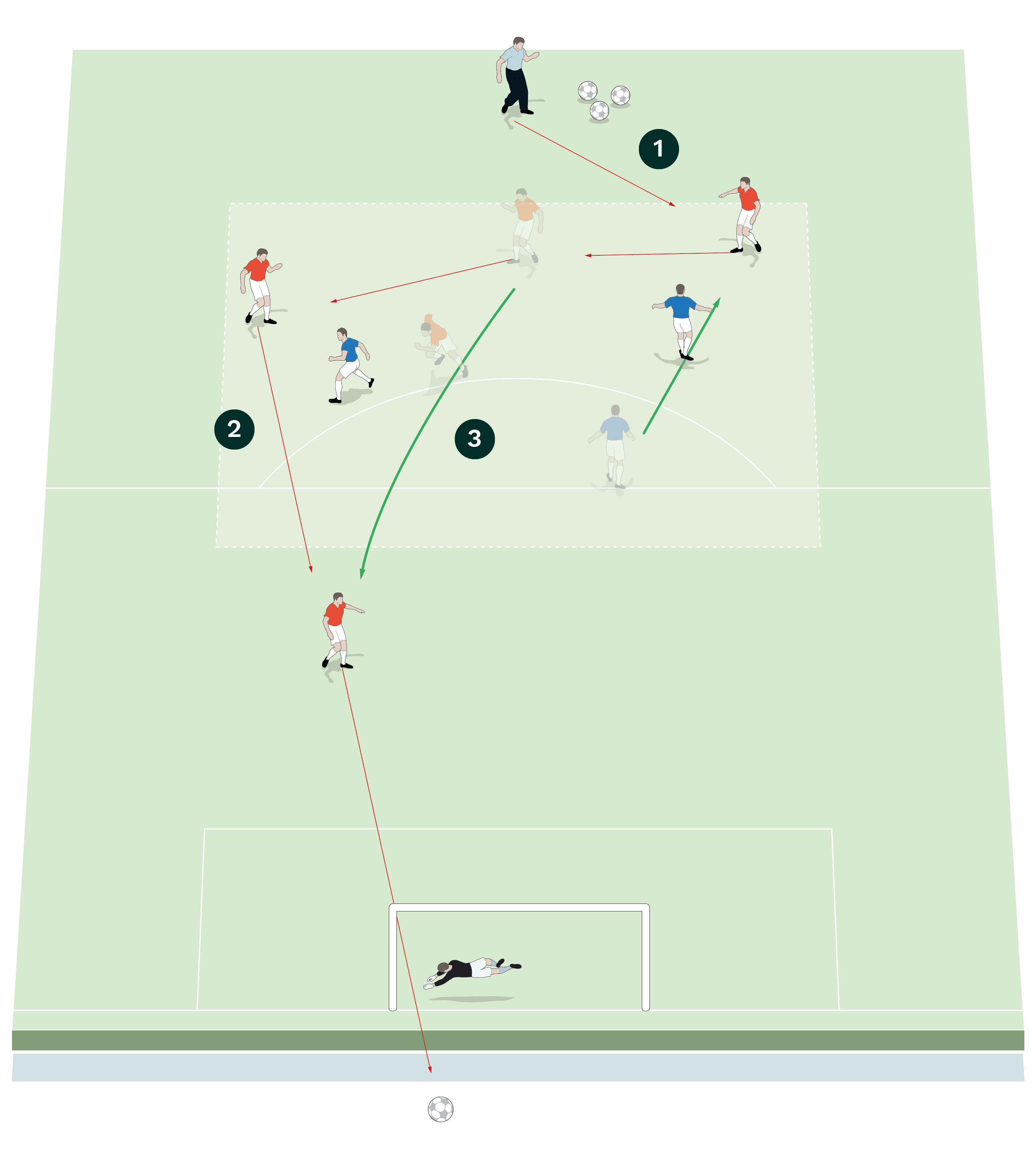
2. Here the reds combine to make space the play a pass behind the blue defender
3. A red attacker makes a diagonal run to receive and finish. As the striker has run into the inner zone, his shot must be taken with a first touch
Attack 2 begins with a second ball being played into the red attackers, who look to find ways to utilise the 2v1 or 3v2 overloads within the outer zone to find the free player who can then strike at goal, as shown [3b].
Attack 3 begins with a third ball being served to the reds and in this example a pass is played in behind the blue defender for a red attacker, who has made a diagonal run to receive and finish past the goalkeeper, as shown [3c]. As he has made a run into the inner zone, his shot must be taken first-time.
We would run this activity for 15 minutes.
“We want to see different types of finishes and players showing they can work effectively with their backs to goal”
SMALL-SIDED GAME
We set up on a full pitch divided into three equal zones. The pitch is coned off to the width of the penalty area to ensure central attacks are created in a similar fashion to those worked on in the previous activities. We have a goal and a goalkeeper at each end and we’re using 14 outfield players split into two balanced team of seven. It’s a directional game and both teams have two players in each end zone and three players each in the centre zone.
Play starts with a pass out from one of the goalkeepers into a defender and the aim is to build an attack through the thirds. If the ball is passed into the next zone, one player from that team can follow the pass into the next zone to help create an overload. Players can dribble the ball into the next zone and stay there while the ball is in that zone, helping to create an overload situation, as shown [4]. Players can rotate when their team is in possession, dropping back from a higher zone into the zone with the ball to create an overload but only one extra player can be in the overloaded zone at a time.
When play is dead, as a progression we could restart play with a ball from the coach to help create the final third action.
We would run this game for 15 minutes.
[4]
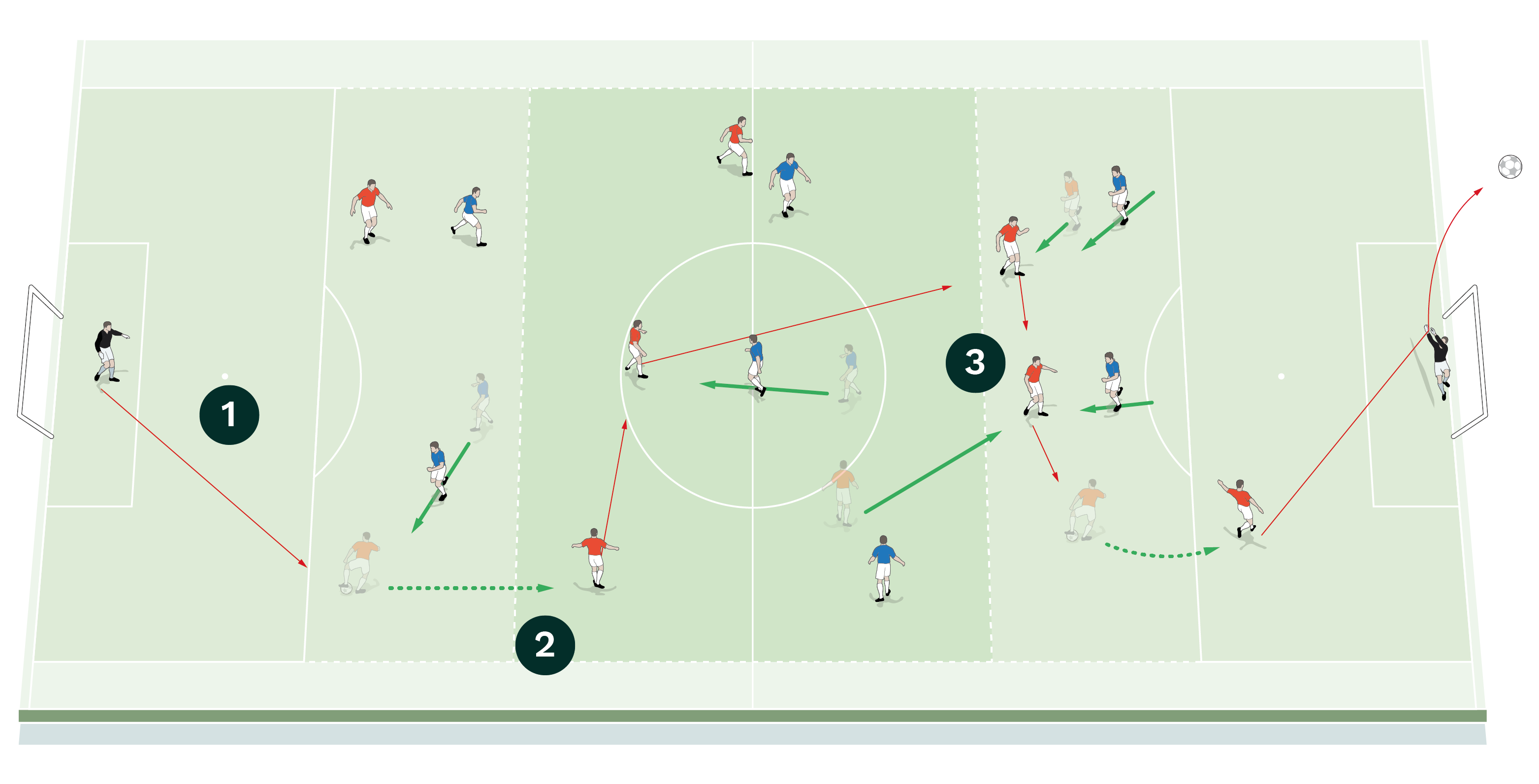
2. One player from the possession team can move up a zone or drop down a zone to give the team an overload. Here a red dribbles into the centre zone, giving the reds a 4v3 midfield overload
3. Here a red midfielder has followed the ball into the next zone to give the reds a 3v2 overload in the attacking end zone
COACHING POINTS
What are the key things to look for?
Key aspects that we want to see from the strikers include good 1v1 play and quick combination play around the box. We want to see them demonstrating sharp reactions and a deadly attitude to shooting, particularly when taking the opportunity to fire through bodies crowding in and around the penalty area. We want to see different types of finishes and players showing they can work effectively with their backs to goal.
We want to see that defenders remain compact and that they are quick to block. We want to see them defending the middle of the goal, demonstrating quick reactions and making contact quickly in the box. In the first activity, when they gain possession we want to see them hitting the mini goals to score on the counter.
What are the typical mistakes players might make and how do I avoid them?
In the first activity, often players do not work the overload well enough and are too eager to shoot. Players in the zone nearest the goal need to be ready to react to balls into their area but be involved in the game to help the deeper three build up the play.
Related Files
Editor's Picks
Intensive boxes drill with goals
Penetrating the final third
Creating and finishing
My philosophy
Pressing initiation
Compact team movement
Defensive organisation
Back three tactics
Counter-pressing as an offensive weapon
Coaches' Testimonials

Alan Pardew

Arsène Wenger

Brendan Rodgers

Carlos Carvalhal

José Mourinho

Jürgen Klopp

Pep Guardiola

Roy Hodgson

Sir Alex Ferguson

Steven Gerrard
Coaches' Testimonials

Gerald Kearney, Downtown Las Vegas Soccer Club

Paul Butler, Florida, USA

Rick Shields, Springboro, USA

Tony Green, Pierrefonds Titans, Quebec, Canada
Join the world's leading coaches and managers and discover for yourself one of the best kept secrets in coaching. No other training tool on the planet is written or read by the calibre of names you’ll find in Elite Soccer.
In a recent survey 92% of subscribers said Elite Soccer makes them more confident, 89% said it makes them a more effective coach and 91% said it makes them more inspired.
Get Monthly Inspiration
All the latest techniques and approaches
Since 2010 Elite Soccer has given subscribers exclusive insight into the training ground practices of the world’s best coaches. Published in partnership with the League Managers Association we have unparalleled access to the leading lights in the English leagues, as well as a host of international managers.
Elite Soccer exclusively features sessions written by the coaches themselves. There are no observed sessions and no sessions “in the style of”, just first-hand advice delivered direct to you from the coach.








